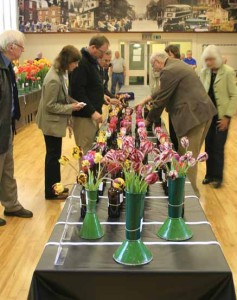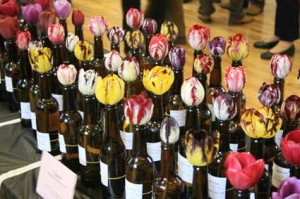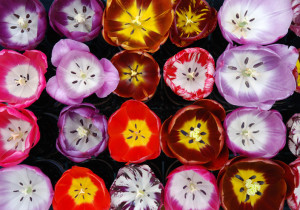From the moment that they were brought to Western Europe in the late 16th century tulips have greatly charmed people. Several times they caused such a frenzy that dramatic social and economic happenings followed, with widespread hysteria and financial ruin for many. Members of the Wakefield Society all have the pleasant affliction of being infatuated with the spring bulb. And not just any tulip, but particularly the English Florists’ tulips, known also as broken tulips, better known in the Netherlands as Rembrandt tulips, and the associated Breeder tulips. The interesting fact is that few society members are professional tulip bulb growers. This was also the case at the beginning of the 19th century when England had more than two hundred tulip societies and each held its own show every year.
“Some society members are railroad employees, some are ministers or bookkeepers while others are estate owners.”
A few had or still have a piece of land along the railroad or they make their community garden plot their own little Garden of Eden. Others grow their tulips around the rectory or vicarage or in an isolated section of a country estate.
Annual Show
 Tulip societies were a typical British phenomenon of the 19th century, but only four were still active at the beginning of the twentieth century. After the dissolution of the Royal National Tulip Society in 1936 only the Wakefield society was still extant. The high point of the society’s calendar is the annual show. Because of the recent long winter and a chilly spring there was some question as to whether there would be a sufficient number of entries for this year’s jubilee show. In fact there were 46 entries, not such a disappointment at all. One of the intriguing aspects of this particular flower show is that the entries are brought out in all sorts of curious containers.
Tulip societies were a typical British phenomenon of the 19th century, but only four were still active at the beginning of the twentieth century. After the dissolution of the Royal National Tulip Society in 1936 only the Wakefield society was still extant. The high point of the society’s calendar is the annual show. Because of the recent long winter and a chilly spring there was some question as to whether there would be a sufficient number of entries for this year’s jubilee show. In fact there were 46 entries, not such a disappointment at all. One of the intriguing aspects of this particular flower show is that the entries are brought out in all sorts of curious containers.
“These are mostly beer crates and bottles, especially from the British brewery Bass, though that seems to be mere coincidence.”
The bottles are not used to increase the festive atmosphere of such an event but to attain uniformity of the show containers and to better assess the quality and the colours of the interior of the flowers. This very traditional display technique dates from the time that these shows were held in pubs in Britain. Other groups use old paint cans or plastic buckets with holes in the cover which similarly stabilize the flowers during the transport to shows from all corners of the British kingdom.
Fine paint brushes
 An important aspect of the show is the ‘staging’ process, the necessary preparations to make flowers ready for judging. With the precision technique of a watchmaker the inside of each flower is cleaned of all minuscule debris and pollen deposits. Tweezers, Q-tips, fine paint brushes and other tiny tools are some of the instruments used. At first, it seems that the flowers of many broken tulips resemble one another. They all have the traditional flames and feathers, as the fascinating colorations are called, or brilliant single colours. After a few hours of information gathering and observation, one learns that the reality is otherwise. There are utmost differences in quality. After the staging is completed, the display of the entries starts. It is almost a ceremony or an initiation rite, presided over by Keith Eyre, Esq. one of the patrons of the society. He calls out the classes, and then the participants set their cherished flower jewels on the benches. White ribbons are placed between the entries to separate the various classes. There are more than thirty of these, ranging from 18 flowers of any kind of tulip not being an English Florists’ Tulip in a vase, to miscellaneous categories of breeders, flames, feathers and several classes for novices.
An important aspect of the show is the ‘staging’ process, the necessary preparations to make flowers ready for judging. With the precision technique of a watchmaker the inside of each flower is cleaned of all minuscule debris and pollen deposits. Tweezers, Q-tips, fine paint brushes and other tiny tools are some of the instruments used. At first, it seems that the flowers of many broken tulips resemble one another. They all have the traditional flames and feathers, as the fascinating colorations are called, or brilliant single colours. After a few hours of information gathering and observation, one learns that the reality is otherwise. There are utmost differences in quality. After the staging is completed, the display of the entries starts. It is almost a ceremony or an initiation rite, presided over by Keith Eyre, Esq. one of the patrons of the society. He calls out the classes, and then the participants set their cherished flower jewels on the benches. White ribbons are placed between the entries to separate the various classes. There are more than thirty of these, ranging from 18 flowers of any kind of tulip not being an English Florists’ Tulip in a vase, to miscellaneous categories of breeders, flames, feathers and several classes for novices.
White and yellow?
Shape and colour are the important features defining a good tulip. The flower should be as near hemispherical in shape as possible, with petals of equal height. The colours are also very distinctive. The society classifies the tulips into three distinct standard types, in the same way as we in the Netherlands do to classify Rembrandt tulips, albeit that the range of colours differs slightly: Roses (the petal coloured pink on a pure white base, in NL we include reds and scarlets), Bybloemen (a petal coloured lilac/purple/almost black on a pure white base; NL also includes mauves) and Bizarren (a petal coloured red – but not pink – to brown on a pure yellow base; NL; we even include (dark) orange). In addition, there are differentiations made between Breeders (the original one-colour tulips), Flames and Feathers. Known earlier as mother tulips, the Breeder tulips are judged mostly on form (the bigger seems often the better), the colours, such as in the three various Rembrandt tulip groups, the clarity of the colours, as well as the purity of the white or yellow base.
“The society classifies the tulips into three distinct standard types, in the same way as we in the Netherlands do to classify Rembrandt tulips, albeit that the range of colours differs slightly….”
The stronger the colour pattern the better it is. The base colour has to be pure, with no blotches of any other colour. And the filaments, which support the anthers, should be the same pure colour as the base. A pure white or yellow base though is essential. If the flowers do not conform to the required characteristics it does not matter how beautiful they are, they cannot be considered English Florists’ tulips.
TBV
With the broken tulips it is the effect of the break of the virus that is of greatest interest. These patterned tulips, infected by the Tulip Breaking Virus (TBV), are referred to as ‘rectified’, their colour is broken to give ‘feathers’ and ‘flames’. These terms describe the pattern of the broken colour on the base colour of the petal; feathered flowers ideally have an unbroken line of colour at the margin of each petal with the central part of the petal showing only the original base colour; flames have the marginal colour plus a central beam of colour and flame-like markings joining the beam to the feathering. The base colour remains pure and is unaffected by TBV.
Trophies and Cups
While the society with its approx. 220 members is considered small, the number of prizes is substantial. Some of the cups and platters are very impressive and named for people who played an important role in the society’s history. Other prizes were inherited from the societies which merged with the Wakefield Society. In addition there are heavily-facetted glass vases which will be inscribed and become the possession of the winners. Occasionally there are remarkable entries in the vase classes with lovely little bouquets of botanical tulips such as T. batalinii ‘Bright Gem’. And every so often these also receive prizes.
Limmen
A not so well-known fact is that a selection of the Rembrandt tulip collection of the Hortus Bulborum was obtained from the Wakefield Society. In the late 1970s and early 1980s there was close contact between Victor Roozen and the Society. And Roozen had good connections with a board member of the Hortus. Roozen would obtain English bulbs which the farmers in Limmen then would grow on. Some of these surplus bulbs would be bought back to the Society which in turn would distribute them among the members to raise for the annual shows. This liaison was somewhat lost due to the death of the Hortus board member.
“‘Goldfinder’ is an absolute favorite among the members, a variety which arrived in Limmen via Mr. Roozen,…”
but which since then has disappeared from the collection of the Hortus. Other varieties which came over were ‘James Wild’ and ‘Sam Barlow’ (Bizarren). ‘Bessie’, ‘Music’ and ‘Talisman’ (Bijbloemen) and ‘Mabel’, ’Gloria’, ‘Juliet’ (Roses). Since recently the connection between the two organizations has been expanded again and the annual exchanges and orders have been reinstated.
Keukenhof
In 2009 there was a very beautiful though brief exhibit in the Oranje-Nassau Pavilion at Keukenhof. Many of both the general public and those in the bulb sector missed the show due to the lack of timely publicity. Although the Society again was invited to exhibit in the Netherlands by Wakefield Society member Jan Pennings, Vice-President of Keukenhof, they recently decided to not participate in 2011. It would be too soon after the initial show and because of the society’s other numerous activities there would be too much pressure on the small and active group within the society. But it is certain that at some point in the future the fabulously beautiful English Florists’ tulips will return again and will be exhibited at Keukenhof or other suitable venue in the Netherlands.
Publications
For those who are interested to learn more about the Wakefield Society there are two useful publications with further information, now in The Netherlands available exclusively at www.hetschrijflokaal.nl.
English Florists’ Tulips, into the 21st century – published for the previous jubilee, this booklet gives a brief overview of the discovery of the tulip break virus, the development of the judging standards, and a list of the varieties which are currently grown.
Old Flames, English Florists’ Tulips – a small and colourful catalogue with pictures of artworks by such well-known artists as Rory McEwen, Celia Hegedüs and Lady Ann Fraser. The website www.tulipsociety.co.uk provides more information on the venerable society.
(July 3, 2010, Leslie Leijenhorst)
This article is based on the Dutch version that has been published in the trade magazine of the bulb industry Bloembollenvisie on July 1, 2010, nr. 196. It has been edited at certain points and elaborated.
Special thanks to Teresa Clements (WNET Society) as well as Jane Baldwin-Gerlach for making some highly valuable comments on earlier drafts of the text.


